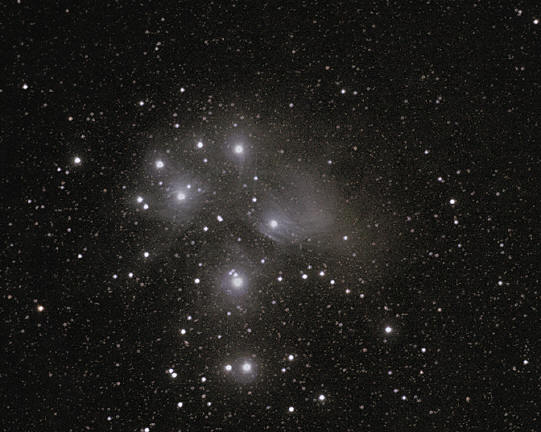Daylight saving time ends at 2 a.m. on Sunday following, November 5th, so fall back to CST. The last quarter moon rises at midnight on November 10th. On the morning of the 13th, the waning crescent moon sits above a spectacular conjunction of the two brightest planets, Venus and Jupiter, which are less than a moon diameter (only .3 degrees)
apart; both rise about 5 a.m. locally. The crescent moon will pass three degrees north of Mars on November 14th, and then by Jupiter on November 16th. It is new moon on November 18th, which is also the peak for the Leonid meteor shower, peaking in the dawn that morning with no moonlight to interfere. The waxing crescent moon passes by Mercury and Saturn in the SW
twilight about 5:30 p.m. on the evening of November 20th. The Moon is first quarter on November 26th. Mercury passes three degrees south of Saturn low in SW twilight on November 28th; this will be your last shot at the ringed wonder, which will be lost in the Sunís glare in December.
While the naked eye, dark adapted by several minutes away from any bright lights, is a wonderful instrument to stare up into deep space, far beyond our own Milky Way, binoculars are better for spotting specific deep sky objects. For a detailed map of northern hemisphere skies visit the www.skymaps.com website and download the map for
November; it will have a more extensive calendar, and list of best objects for the naked eyes, binoculars, and scopes on the back of the map.
It is not a good month to spot the planets in the evening sky; catch Saturn and Mercury right after sunset, low in the SW; Saturn is lost in the sunís glare by midmonth. Venus is heading behind the Sun as well, but does have a nice conjunction with Jupiter on the morning of November 13th. Mars is moving eastward in Virgo, passing north of
Spica in the dawn at monthís end. Jupiter is rising about 5 a.m. as November begins in Libra, and dominates the dawn skies for the next several months.
Setting in the southwest is the teapot shape of Sagittarius, which marks the heart of our Milky Way Galaxy, but the best view of our Galaxy lies overhead now. The brightest star of the northern hemisphere, Vega dominates the sky in the northwest. To the northeast of Vega is Deneb, the brightest star of Cygnus the Swan. To the south is
Altair, the brightest star of Aquila the Eagle, the third member of the three bright stars that make the Summer Triangle so obvious in the NE these clear autumn evenings. Use binocs and your sky map to spot many clusters here, using the SkyMap download to locate some of the best ones plotted and described on the back.
Overhead the square of Pegasus is a beacon of fall. South of it is the only bright star of Fall, Fomalhaut. If the southern skies of Fall look sparse, it is because we are looking away from our Galaxy into the depths of intergalactic space.
The constellation Cassiopeia makes a striking W, rising in the NE as the Big Dipper sets in the NW. Polaris lies about midway between them. She contains many nice star clusters for binocular users in her outer arm of our Milky Way, extending to the NE now. Her daughter, Andromeda, starts with the NE corner star of Pegasusíí Square, and goes
NE with two more bright stars in a row. It is from the middle star, beta Andromeda, that we proceed about a quarter the way to the top star in the W of Cassiopeia, and look for a faint blur with the naked eye. M-31, the Andromeda Galaxy, is the most distant object visible with the naked eye, lying about 2.5 million light years distant.
To the northeast, Andromedaís hero, Perseus, rises. Perseus contains the famed eclipsing binary star Algol, where the Arabs imagined the eye of the gorgon Medusa would lie. It fades to a third its normal brightness for six out of every 70 hours, as a larger but cooler orange giant covers about 80% of the smaller but hotter and thus brighter
companion as seen from Earth. south. Look at Perseusí feet for the famed Pleiades cluster to rise, a sure sign of bright winter stars to come. This is probably the best sight in the sky with binoculars, with hundreds of fainter stars joining the famed "Seven Sisters" with 10x50 binocs. The cluster lies about 440 light years distant according to the latest work by
the Gaia astrometric satellite early in 2017. The cloud of gas and dust may be left over from the formation of this young cluster only 100 million years ago, but more likely is just "intergalactic cirrus" dust scattering the blue light of the hot young stars moving through the reflection nebulae very beautifully in this portrait.

In fact, yellow Capella, a giant star the same temperature and color as our much smaller Sun, rises at 7 p.m. as November begins along the northeastern horizon. It is the fifth brightest star in the sky, and a beacon of the colorful and bright winter stars to come.